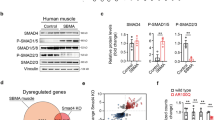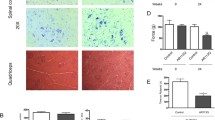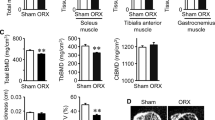Abstract
Hypogonadism contributes to limb skeletal muscle atrophy by increasing rates of muscle protein breakdown. Androgen depletion increases markers of the autophagy protein breakdown pathway in the limb muscle that persist throughout the diurnal cycle. However, the regulatory signals underpinning the increase in autophagy markers remain ill-defined. The purpose of this study was to characterize changes to autophagy regulatory signals in the limb skeletal muscle following androgen depletion. Male mice were subjected to a castration surgery or a sham surgery as a control. Seven weeks post-surgery, a subset of mice from each group was sacrificed every 4 hr over a 24 hr period. Protein and mRNA from the Tibialis Anterior (TA) were subjected to Western blot and RT-PCR. Consistent with an overall increase in autophagy, the phosphorylation pattern of Uncoordinated Like Kinase 1 (ULK1) (Ser555) was elevated throughout the diurnal cycle in the TA of castrated mice. Factors that induce the progression of autophagy were also increased in the TA following androgen depletion including an increase in the phosphorylation of c-Jun N-terminal Kinase (JNK) (Thr183/Tyr185) and an increase in the ratio of BCL-2 Associated X (BAX) to B-cell lymphoma 2 (BCL-2). Moreover, we observed an increase in the protein expression pattern of p53 and the mRNA of the p53 target genes Cyclin-Dependent Kinase Inhibitor 1A (p21) and Growth Arrest and DNA Damage Alpha (Gadd45a), which are known to increase autophagy and induce muscle atrophy. These data characterize novel changes to autophagy regulatory signals in the limb skeletal muscle following androgen deprivation.




Similar content being viewed by others
References
Powers SK, Lynch GS, Murphy KT, Reid MB, Zijdewind I (2016) Disease-induced skeletal muscle atrophy and fatigue. Med Sci Sports Exerc 48:2307–2319. https://doi.org/10.1249/MSS.0000000000000975
Srikanthan P, Karlamangla AS (2014) Muscle mass index as a predictor of longevity in older adults. Am J Med 127:547–553. https://doi.org/10.1016/j.amjmed.2014.02.007
Srikanthan P, Horwich TB, Tseng CH (2016) Relation of muscle mass and fat mass to cardiovascular disease mortality. Am J Cardiol 117:1355–1360. https://doi.org/10.1016/j.amjcard.2016.01.033
Joskova V, Patkova A, Havel E, Najpaverova S, Uramova D, Kovarik M, Zadak Z, Hronek M (2018) Critical evaluation of muscle mass loss as a prognostic marker of morbidity in critically ill patients and methods for its determination. J Rehabil Med 50:696–704. https://doi.org/10.2340/16501977-2368
Bhasin S, Storer TW, Berman N, Callegari C, Clevenger B, Phillips J, Bunnell TJ, Tricker R, Shirazi A, Casaburi R (1996) The effects of supraphysiologic doses of testosterone on muscle size and strength in normal men. N Engl J Med 335:1–7. https://doi.org/10.1056/NEJM199607043350101
Bhasin S, Storer TW, Berman N, Yarasheski KE, Clevenger B, Phillips J, Lee WP, Bunnell TJ, Casaburi R (1997) Testosterone replacement increases fat-free mass and muscle size in hypogonadal men. J Clin Endocrinol Metab 82:407–413. https://doi.org/10.1210/jcem.82.2.3733
Bhasin S, Woodhouse L, Casaburi R, Singh AB, Mac RP, Lee M, Yarasheski KE, Sinha-Hikim I, Dzekov C, Dzekov J, Magliano L, Storer TW (2005) Older men are as responsive as young men to the anabolic effects of graded doses of testosterone on the skeletal muscle. J Clin Endocrinol Metab 90:678–688. https://doi.org/10.1210/jc.2004-1184
Ferrando AA, Sheffield-Moore M, Yeckel CW, Gilkison C, Jiang J, Achacosa A, Lieberman SA, Tipton K, Wolfe RR, Urban RJ (2002) Testosterone administration to older men improves muscle function: molecular and physiological mechanisms. Am J Physiol Endocrinol Metab 282:E601–E607. https://doi.org/10.1152/ajpendo.00362.2001
Ferrando AA, Sheffield-Moore M, Paddon-Jones D, Wolfe RR, Urban RJ (2003) Differential anabolic effects of testosterone and amino acid feeding in older men. J Clin Endocrinol Metab 88:358–362. https://doi.org/10.1210/jc.2002-021041
Urban RJ, Bodenburg YH, Gilkison C, Foxworth J, Coggan AR, Wolfe RR, Ferrando A (1995) Testosterone administration to elderly men increases skeletal muscle strength and protein synthesis. Am J Phys 269:E820–E826
Kim J, Wang Z, Heymsfield SB, Baumgartner RN, Gallagher D (2002) Total-body skeletal muscle mass: estimation by a new dual-energy X-ray absorptiometry method. Am J Clin Nutr 76:378–383. https://doi.org/10.1093/ajcn/76.2.378
Metzger SO, Burnett AL (2016) Impact of recent FDA ruling on testosterone replacement therapy (TRT). Transl Androl Urol 5:921–926. https://doi.org/10.21037/tau.2016.09.08
Amos-Landgraf JM, Heijmans J, Wielenga MC, Dunkin E, Krentz KJ, Clipson L, Ederveen AG, Groothuis PG, Mosselman S, Muncan V, Hommes DW, Shedlovsky A, Dove WF, van den Brink GR (2014) Sex disparity in colonic adenomagenesis involves promotion by male hormones, not protection by female hormones. Proc Natl Acad Sci U S A 111:16514–16519. https://doi.org/10.1073/pnas.1323064111
Fowler JE, Whitmore WF (1982) Considerations for the use of testosterone with systemic chemotherapy in prostatic cancer. Cancer 49:1373–1377. https://doi.org/10.1002/1097-0142(19820401)49:7<1373::aid-cncr2820490712>3.0.co;2-g
Basaria S, Coviello AD, Travison TG, Storer TW, Farwell WR, Jette AM, Eder R, Tennstedt S, Ulloor J, Zhang A, Choong K, Lakshman KM, Mazer NA, Miciek R, Krasnoff J, Elmi A, Knapp PE, Brooks B, Appleman E, Aggarwal S, Bhasin G, Hede-Brierley L, Bhatia A, Collins L, LeBrasseur N, Fiore LD, Bhasin S (2010) Adverse events associated with testosterone administration. N Engl J Med 363:109–122. https://doi.org/10.1056/NEJMoa1000485
Rossetti ML, Gordon BS (2017) The role of androgens in the regulation of muscle oxidative capacity following aerobic exercise training. Appl Physiol Nutr Metab 42:1001–1007. https://doi.org/10.1139/apnm-2017-0230
Rossetti ML, Steiner JL, Gordon BS (2018) Increased mitochondrial turnover in the skeletal muscle of fasted, castrated mice is related to the magnitude of autophagy activation and muscle atrophy. Mol Cell Endocrinol. https://doi.org/10.1016/j.mce.2018.01.017
Rossetti ML, Esser KA, Lee C, Tomko RJ, Eroshkin AM, Gordon BS (2019) Disruptions to the limb muscle core molecular clock coincide with changes in mitochondrial quality control following androgen depletion. Am J Physiol Endocrinol Metab 317:E631–E645. https://doi.org/10.1152/ajpendo.00177.2019
Steiner JL, Fukuda DH, Rossetti ML, Hoffman JR, Gordon BS (2017) Castration alters protein balance after high-frequency muscle contraction. J Appl Physiol (1985) 122:264–272. https://doi.org/10.1152/japplphysiol.00740.2016
Serra C, Sandor NL, Jang H, Lee D, Toraldo G, Guarneri T, Wong S, Zhang A, Guo W, Jasuja R, Bhasin S (2013) The effects of testosterone deprivation and supplementation on proteasomal and autophagy activity in the skeletal muscle of the male mouse: differential effects on high-androgen responder and low-androgen responder muscle groups. Endocrinology 154:4594–4606. https://doi.org/10.1210/en.2013-1004
Dikic I, Elazar Z (2018) Mechanism and medical implications of mammalian autophagy. Nat Rev Mol Cell Biol 19:349–364. https://doi.org/10.1038/s41580-018-0003-4
Gordon BS, Liu C, Steiner JL, Nader GA, Jefferson LS, Kimball SR (2016) Loss of REDD1 augments the rate of the overload-induced increase in muscle mass. Am J Physiol Regul Integr Comp Physiol 311:R545–R557. https://doi.org/10.1152/ajpregu.00159.2016
Kim J, Kundu M, Viollet B, Guan KL (2011) AMPK and mTOR regulate autophagy through direct phosphorylation of Ulk1. Nat Cell Biol 13:132–141. https://doi.org/10.1038/ncb2152
Kim J, Guan KL (2013) AMPK connects energy stress to PIK3C3/VPS34 regulation. Autophagy 9:1110–1111. https://doi.org/10.4161/auto.24877
Russell RC, Yuan HX, Guan KL (2014) Autophagy regulation by nutrient signaling. Cell Res 24:42–57. https://doi.org/10.1038/cr.2013.166
Lira VA, Okutsu M, Zhang M, Greene NP, Laker RC, Breen DS, Hoehn KL, Yan Z (2013) Autophagy is required for exercise training-induced skeletal muscle adaptation and improvement of physical performance. FASEB J 27:4184–4193. https://doi.org/10.1096/fj.13-228486
Fry CS, Drummond MJ, Glynn EL, Dickinson JM, Gundermann DM, Timmerman KL, Walker DK, Volpi E, Rasmussen BB (2013) Skeletal muscle autophagy and protein breakdown following resistance exercise are similar in younger and older adults. J Gerontol A Biol Sci Med Sci 68:599–607. https://doi.org/10.1093/gerona/gls209
Jacobi D, Liu S, Burkewitz K, Kory N, Knudsen NH, Alexander RK, Unluturk U, Li X, Kong X, Hyde AL, Gangl MR, Mair WB, Lee CH (2015) Hepatic Bmal1 regulates rhythmic mitochondrial dynamics and promotes metabolic fitness. Cell Metab 22:709–720. https://doi.org/10.1016/j.cmet.2015.08.006
Cao X, Rui L, Pennington PR, Chlan-Fourney J, Jiang Z, Wei Z, Li XM, Edmondson DE, Mousseau DD (2009) Serine 209 resides within a putative p38(MAPK) consensus motif and regulates monoamine oxidase-A activity. J Neurochem 111:101–110. https://doi.org/10.1111/j.1471-4159.2009.06300.x
Liu Z, Sin KWT, Ding H, Doan HA, Gao S, Miao H, Wei Y, Wang Y, Zhang G, Li YP (2018) p38β MAPK mediates ULK1-dependent induction of autophagy in skeletal muscle of tumor-bearing mice. Cell Stress 2:311–324. https://doi.org/10.15698/cst2018.11.163
Wong PM, Feng Y, Wang J, Shi R, Jiang X (2015) Regulation of autophagy by coordinated action of mTORC1 and protein phosphatase 2A. Nat Commun 6:8048. https://doi.org/10.1038/ncomms9048
Pattingre S, Tassa A, Qu X, Garuti R, Liang XH, Mizushima N, Packer M, Schneider MD, Levine B (2005) Bcl-2 antiapoptotic proteins inhibit Beclin 1-dependent autophagy. Cell 122:927–939. https://doi.org/10.1016/j.cell.2005.07.002
Marquez RT, Xu L (2012) Bcl-2:Beclin 1 complex: multiple, mechanisms regulating autophagy/apoptosis toggle switch. Am J Cancer Res 2:214–221
Wei Y, Pattingre S, Sinha S, Bassik M, Levine B (2008) JNK1-mediated phosphorylation of Bcl-2 regulates starvation-induced autophagy. Mol Cell 30:678–688. https://doi.org/10.1016/j.molcel.2008.06.001
Lindqvist LM, Heinlein M, Huang DC, Vaux DL (2014) Prosurvival Bcl-2 family members affect autophagy only indirectly, by inhibiting Bax and Bak. Proc Natl Acad Sci U S A 111:8512–8517. https://doi.org/10.1073/pnas.1406425111
Tam BT, Yu AP, Tam EW, Monks DA, Wang XP, Pei XM, Koh SP, Sin TK, Law HKW, Ugwu FN, Supriya R, Yung BY, Yip SP, Wong SC, Chan LW, Lai CW, Ouyang P, Siu PM (2018) Ablation of Bax and Bak protects skeletal muscle against pressure-induced injury. Sci Rep 8:3689. https://doi.org/10.1038/s41598-018-21853-5
Fox DK, Ebert SM, Bongers KS, Dyle MC, Bullard SA, Dierdorff JM, Kunkel SD, Adams CM (2014) p53 and ATF4 mediate distinct and additive pathways to skeletal muscle atrophy during limb immobilization. Am J Physiol Endocrinol Metab 307:E245–E261. https://doi.org/10.1152/ajpendo.00010.2014
White E (2016) Autophagy and p53. Cold Spring Harb Perspect Med 6:a026120. https://doi.org/10.1101/cshperspect.a026120
Gotoh T, Vila-Caballer M, Santos CS, Liu J, Yang J, Finkielstein CV (2014) The circadian factor Period 2 modulates p53 stability and transcriptional activity in unstressed cells. Mol Biol Cell 25:3081–3093. https://doi.org/10.1091/mbc.E14-05-0993
Denisenko TV, Pivnyuk AD, Zhivotovsky B (2018) p53-autophagy-metastasis link. Cancers (Basel) 10. https://doi.org/10.3390/cancers10050148
Capparelli C, Chiavarina B, Whitaker-Menezes D, Pestell TG, Pestell RG, Hulit J, Andò S, Howell A, Martinez-Outschoorn UE, Sotgia F, Lisanti MP (2012) CDK inhibitors (p16/p19/p21) induce senescence and autophagy in cancer-associated fibroblasts, “fueling” tumor growth via paracrine interactions, without an increase in neo-angiogenesis. Cell Cycle 11:3599–3610. https://doi.org/10.4161/cc.21884
Ebert SM, Dyle MC, Kunkel SD, Bullard SA, Bongers KS, Fox DK, Dierdorff JM, Foster ED, Adams CM (2012) Stress-induced skeletal muscle Gadd45a expression reprograms myonuclei and causes muscle atrophy. J Biol Chem 287:27290–27301. https://doi.org/10.1074/jbc.M112.374777
White JP, Billin AN, Campbell ME, Russell AJ, Huffman KM, Kraus WE (2018) The AMPK/p27 Kip1 axis regulates autophagy/apoptosis decisions in aged skeletal muscle stem cells. Stem Cell Reports 11:425–439
Brady OA, Jeong E, Martina JA, Pirooznia M, Tunc I, Puertollano R (2018) The transcription factors TFE3 and TFEB amplify p53 dependent transcriptional programs in response to DNA damage. Elife 7. https://doi.org/10.7554/eLife.40856
Wang S, Chen Y, Li X, Zhang W, Liu Z, Wu M, Pan Q, Liu H (2020) Emerging role of transcription factor EB in mitochondrial quality control. Biomed Pharmacother 128:110272. https://doi.org/10.1016/j.biopha.2020.110272
Ebert SM, Monteys AM, Fox DK, Bongers KS, Shields BE, Malmberg SE, Davidson BL, Suneja M, Adams CM (2010) The transcription factor ATF4 promotes skeletal myofiber atrophy during fasting. Mol Endocrinol 24:790–799. https://doi.org/10.1210/me.2009-0345
Kimball SR, Jefferson LS (2012) Induction of REDD1 gene expression in the liver in response to endoplasmic reticulum stress is mediated through a PERK, eIF2α phosphorylation, ATF4-dependent cascade. Biochem Biophys Res Commun 427:485–489. https://doi.org/10.1016/j.bbrc.2012.09.074
Laker RC, Drake JC, Wilson RJ, Lira VA, Lewellen BM, Ryall KA, Fisher CC, Zhang M, Saucerman JJ, Goodyear LJ, Kundu M, Yan Z (2017) Ampk phosphorylation of Ulk1 is required for targeting of mitochondria to lysosomes in exercise-induced mitophagy. Nat Commun 8:548. https://doi.org/10.1038/s41467-017-00520-9
Bujak AL, Crane JD, Lally JS, Ford RJ, Kang SJ, Rebalka IA, Green AE, Kemp BE, Hawke TJ, Schertzer JD, Steinberg GR (2015) AMPK activation of muscle autophagy prevents fasting-induced hypoglycemia and myopathy during aging. Cell Metab 21:883–890. https://doi.org/10.1016/j.cmet.2015.05.016
Drake JC, Yan Z (2017) Mitophagy in maintaining skeletal muscle mitochondrial proteostasis and metabolic health with ageing. J Physiol 595:6391–6399. https://doi.org/10.1113/JP274337
White JP, Gao S, Puppa MJ, Sato S, Welle SL, Carson JA (2013) Testosterone regulation of Akt/mTORC1/FoxO3a signaling in skeletal muscle. Mol Cell Endocrinol 365:174–186. https://doi.org/10.1016/j.mce.2012.10.019
Ghanim H, Dhindsa S, Batra M, Green K, Abuaysheh S, Kuhadiya ND, Makdissi A, Chaudhuri A, Sandhu S, Dandona P (2020) Testosterone increases the expression and phosphorylation of AMP kinase α in men with hypogonadism and type 2 diabetes. J Clin Endocrinol Metab 105. https://doi.org/10.1210/clinem/dgz288
Kaplan SA, Crawford ED (2006) Relationship between testosterone levels, insulin sensitivity, and mitochondrial function in men. Diabetes Care 29:749; author reply 749–750. https://doi.org/10.2337/diacare.29.03.06.dc05-2100
Cárdenas C, Miller RA, Smith I, Bui T, Molgó J, Müller M, Vais H, Cheung KH, Yang J, Parker I, Thompson CB, Birnbaum MJ, Hallows KR, Foskett JK (2010) Essential regulation of cell bioenergetics by constitutive InsP3 receptor Ca2+ transfer to mitochondria. Cell 142:270–283. https://doi.org/10.1016/j.cell.2010.06.007
Cárdenas C, Müller M, McNeal A, Lovy A, Jaňa F, Bustos G, Urra F, Smith N, Molgó J, Diehl JA, Ridky TW, Foskett JK (2016) Selective vulnerability of cancer cells by inhibition of Ca(2+) transfer from endoplasmic reticulum to mitochondria. Cell Rep 15:219–220. https://doi.org/10.1016/j.celrep.2016.03.045
Rossetti ML, Fukuda DH, Gordon BS (2018) Androgens induce growth of the limb skeletal muscles in a rapamycin-insensitive manner. Am J Physiol Regul Integr Comp Physiol. https://doi.org/10.1152/ajpregu.00029.2018
Giaccia AJ, Kastan MB (1998) The complexity of p53 modulation: emerging patterns from divergent signals. Genes Dev 12:2973–2983. https://doi.org/10.1101/gad.12.19.2973
Pan C, Singh S, Sahasrabudhe DM, Chakkalakal JV, Krolewski JJ, Nastiuk KL (2016) TGFβ superfamily members mediate androgen deprivation therapy-induced obese frailty in male mice. Endocrinology 157:4461–4472. https://doi.org/10.1210/en.2016-1580
Wang DT, Yang YJ, Huang RH, Zhang ZH, Lin X (2015) Myostatin activates the ubiquitin-proteasome and autophagy-lysosome systems contributing to muscle wasting in chronic kidney disease. Oxidative Med Cell Longev 2015:684965. https://doi.org/10.1155/2015/684965
Smuder AJ, Sollanek KJ, Nelson WB, Min K, Talbert EE, Kavazis AN, Hudson MB, Sandri M, Szeto HH, Powers SK (2018) Crosstalk between autophagy and oxidative stress regulates proteolysis in the diaphragm during mechanical ventilation. Free Radic Biol Med 115:179–190. https://doi.org/10.1016/j.freeradbiomed.2017.11.025
Sandri M (2013) Protein breakdown in muscle wasting: role of autophagy-lysosome and ubiquitin-proteasome. Int J Biochem Cell Biol 45:2121–2129. https://doi.org/10.1016/j.biocel.2013.04.023
Funding
This work was supported by funds from Institute of Successful Longevity and Florida State University to BSG.
Author information
Authors and Affiliations
Corresponding author
Ethics declarations
Conflict of Interest
The authors report no conflicts of interest.
Additional information
Publisher’s Note
Springer Nature remains neutral with regard to jurisdictional claims in published maps and institutional affiliations.
Rights and permissions
About this article
Cite this article
Rossetti, M.L., Tomko, R.J. & Gordon, B.S. Androgen depletion alters the diurnal patterns to signals that regulate autophagy in the limb skeletal muscle. Mol Cell Biochem 476, 959–969 (2021). https://doi.org/10.1007/s11010-020-03963-9
Received:
Accepted:
Published:
Issue Date:
DOI: https://doi.org/10.1007/s11010-020-03963-9




